On December 3, 2019, Russia celebrated the 60th anniversary of its nuclear-powered icebreaker fleet. On this day in 1959, the Leningrad Admiralty shipyard and the Gorky machine-building plant no.92, the main executioners, delivered Lenin, the first nuclear-powered icebreaker to its commissioner, the Ministry of the Navy. Judging by the level of technology involved, the concentration of effort put into its manufacturing (work being spread among more than 500 enterprises across the country), the nuclear-powered icebreaker can easily be compared to spaceships and stations. The creation of the only nuclear-powered icebreaker fleet on the planet is a landmark event that marked the beginning of a completely new stage in the development of the country.
The Northern Sea Route, whose opening took several centuries and required heroic efforts from its pioneers became has become a transport artery which provides a completely unique access to our Arctic settlements and gives us the opportunity to tame vast territories adjacent not only to the coast of the Artic Ocean but also to the shores of great Siberian rivers: the Ob, Yenisei, Lena and Kolyma. Despite all the changes that occurred in its political system since the beginning of the 20th century, Russia has always put great effort into becoming the “master of the Artic”. New trading posts and settlements were made, geologists have explored the undergrounds of all the places they could possibly get to, but the harsh climate and the underdeveloped transport facilities turned out to be an almost insurmountable obstacle. The focal taming of the Arctic zone, Eastern Siberia, Yakutia and most of the Far East is a heritage we certainly can be proud of, but it is also a challenge we have to face: Can we go even further? Will we achieve more than our predecessors did?
The Arctic creates demand
The main issue with the taming of the Arctic is during the first half of the 20th century is the lack of transportation access to the NSR (Northern Sea Route) during nine months out of twelve. The icebreakers (that first functioned on solid then liquid fuel) could not cope with two problems at once : ice fields and hummocks, and the fact that there was not enough ship fuel supply to cover the entire route. Cargo ships had to be accompanied not only by food, equipment and fuel supplies for new ports and industrial zones, but also tankers carrying fuel for the ships themselves. Bunkering a ship in high seas has never been an easy operation. In the Artic, however, it is twice or even thrice as difficult: not only is there the sea swell, but also severe ice conditions. The engines of the icebreakers didn’t have enough power nor fuel and their hulls could not cope with heavy, strong and thick ice.
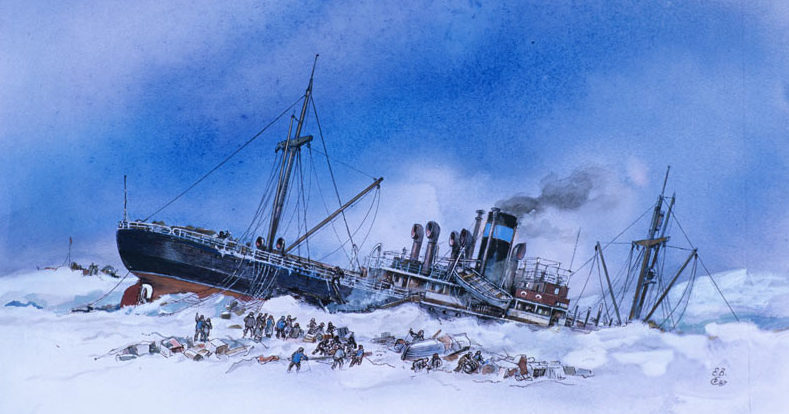
The history of the Artic in the first half of the 20th century is a tale of man’s battles against climate, weather conditions, and overall human exploit. In 1933, the navigation of the icebreaking steamship Chelyuskin ended with the event of crewmembers (who managed to land on ice) having to be rescued by pilots. With all respect due to the people who managed to conduct this rescue operation, we must not forget about the reasons that made it necessary: Chelyuskin was first sandwiched with ice which it didn’t manage to cope with. The pressure of the ice then got to a point where the ship’s hull couldn’t withstand it anymore, which lead to the sinking of the ship. The polar research expeditions of that time, the famous North Pole stations, also did not have the possibility to work their full potential out because the specific areas of the Artic Ocean they were interested could only be explored by plane which definitely did not always manage to successfully land on ice nor take off from it. This also meant that scientists were only allowed to carry a minimal amount of equipment, which limited them to conducting a minimal set of studies and measurements. To keep it short, around the beginning of the 50s, the main directorate of the Northern Sea Route, scientists, researchers and industrial regions of the far North all had extremely high demand for icebreakers that could get through thick ice and ensure longer navigation time.
The atom became peaceful in the country
Because of the need for military defense in the Soviet Union in 1945, an atomic project was inevitably launched: there simply was no other way out for a country that had just emerged from the most terrible, the most destructive war in the history of civilization. The Special Committee on Atomic Nuclear Energy was formed with a clear purpose: the country needed its own nuclear weaponry, technology and industry in order to ensure nuclear parity with the United States. We were not the first ones in the atomic project, it was thus a priority to first catch up with the Americans who were already far ahead of us. But here’s what’s surprising: back in 1922, the great Russian scientist Vladimir Vernadsky was one of the first to speak words about the mighty energy hidden inside the tiny particles of matter. These words became a motto for soviet nuclear scientists in many ways:
“We are approaching a great upheaval in the life of mankind, one that no previously experienced event can be compared nor compete with. Soon will come the time when men will hold atomic energy in their own hands the source of a force that will allow them to build their lives the way they want. Will men be able to use this force for the sake of good and not self-destruction? Scientists should not turn a blind eye to the possible consequences of their research and progress. They must connect their work with the best organization of all mankind”.
We were not the first ones on the atomic project, but only on the part that dealt with destructive power. However, everything related to the creative role of atomic energy, the very core of this “best organization of all mankind”, first appeared in the USSR. Even in the very first years of the atomic project, scientists, although urged to develop a nuclear weapon, were preparing for the development of a “peaceful atom”. The fact that the very first nuclear power plant was created in USSR goes without saying. What is even more logical is that it is in fact our scientists who were the first to think about using the energy of uranium fission to benefit peaceful life in the country. In November 1949, at the initiative of Igor Vasilyevich Kurchatov, the Scientific and Technical Council of the Special Committee reviewed and supported Semyon Feinberg’s ideas about the possibilities of “creating three versions of an atomic engine for the submarine fleet (water, gas and metal cooling), with an engine power of 10’000 kW per shaft”.
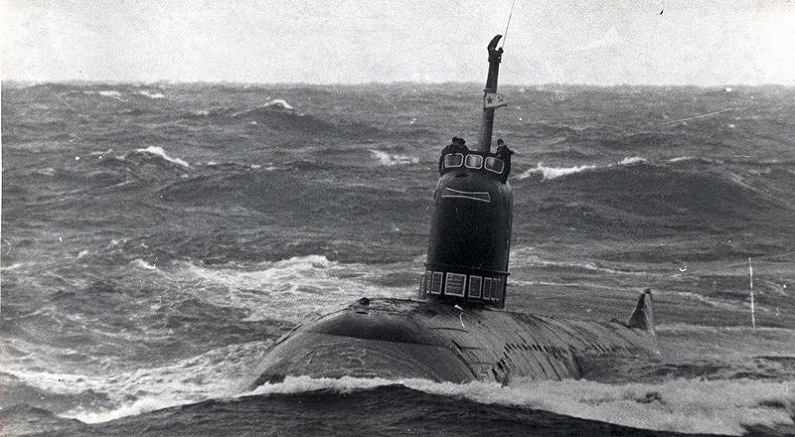
The first nuclear engine was created for the submarine Leninsky Komsomol. It was a requirement from the Ministry of Defense, but the elaboration and construction of a small water transport reactor gave scientists and designers the experience they needed in order to create nuclear-powered installations for a completely new type of icebreaker. The pilot operation of the first nuclear submarine made it possible to correct all the flaws that were identified by sailors, including the short lifetime of the reactor’s core and the low efficiency of the steam generator caused by loss of tightness in the pipelines.
The Artic begins in Saint Petersburg and Nizhny Novgorod
Designers of the Gorky plant No.92, whose head was Igor Ivanovich Afrikantov, gained experience by working on the first transport reactor. Nowadays The Experimental Design Bureau of Mechanical Engineering (OKBM) bares the name of this outstanding scientist and designer, as it is precisely the OKMB that designed and developed nuclear installations for all generations of both nuclear submarines and nuclear icebreakers. In November 1953, the USSR Council of Ministers adopted a decree on the construction of a nuclear-powered icebreaker in which the main tasks were outlined: it was required to create an icebreaking vessel with a nuclear power installation that “was to provide the possibility of continuous escort of caravans of cargo ships on the NSR for 6-8 months, and up to 12-14 months when performing special tasks.” In the summer of 1954, a new decree was adopted by the Council in which were outlined the different stages for accomplishing this assignment, and in which said assignment’s main executors were appointed. The scientific management of the project was entrusted to the Kurchatov Institute, the design of the nuclear steam installation was assigned to plant No.92 and the design of the ship itself was given to the Leningrad TsKB-15, which is now known as the Central Design Bureau “Iceberg”.
Of course, the 60th anniversary of the Atomflot was mainly and solemnly celebrated in Murmansk where its base is located, but December 3rd is an important day for atomic engineers of the OKBM and for shipbuilders of the Iceberg Central Design Bureau. While the OKBM developed all the nuclear power installations of the icebreakers, the designers from Iceberg were the designers and developers of all of the country’s icebreakers, from the firstborn of the Lenin nuclear industry to the latest nuclear icebreakers of the LK-60 series. It is also at Iceberg that was developed the project of the “Leader” icebreaker which is meant to become the key to year-round navigation in the eastern part of the NSR. Saint Petersburg isn’t connected to the Arctic only through Iceberg whose quarters are located in this city, but also through the Baltic Shipyard where three of the newest icebreakers of the 22220 series are under construction: the “Arctic”, the “Ural” and the “Siberia”. “Russian nuclear icebreaker fleet day” is an important day for the whole country and an actual holiday for all professionals in Murmansk, Nizhny Novgorod and St. Petersburg, without whom the creation of these icebreakers could not even be imaginable.
“Lenin”, the world’s first nuclear-powered icebreaker
The nuclear-powered icebreaker Lenin truly was a unique object that interested numerous specialists coming from different fields. It was extremely interesting to shipbuilders who wondered whether or not their design was going to pass the test of ice and frost. Nuclear scientists were interested in how OK-150 reactors would show themselves in business, whether or not they would be able to withstands all the tests on the impacts of ice and collisions with it, whether the refueling operations were calculated correctly, and whether or not a steam generating unit could worth continuously over the course of a year or even more. The nuclear icebreaker was also of great interest to Norilsk factories: would it have the capacity to provide enterprises with everything they need all year round? Will it be possible to export finished products no matter the weather conditions and the time of the year? Even physicians were interested in Lenin, as they were determined to make sure the biological protection was completely reliable. They were also interested in studying the effect on human health of a long stay in the Arctic’s winter frosts and in the polar night. The operation of Lenin was closely monitored by all the groups that took part in its creation: there was more than 500 of them, and together they created 76 new types of mechanisms and 150 new types of equipment specifically for this project. Naturally, the results of the operation were eagerly awaited in all ports along the coast of the Artic ocean, from Murmansk to the Provideniya port on the southeast coast of Chukotka.
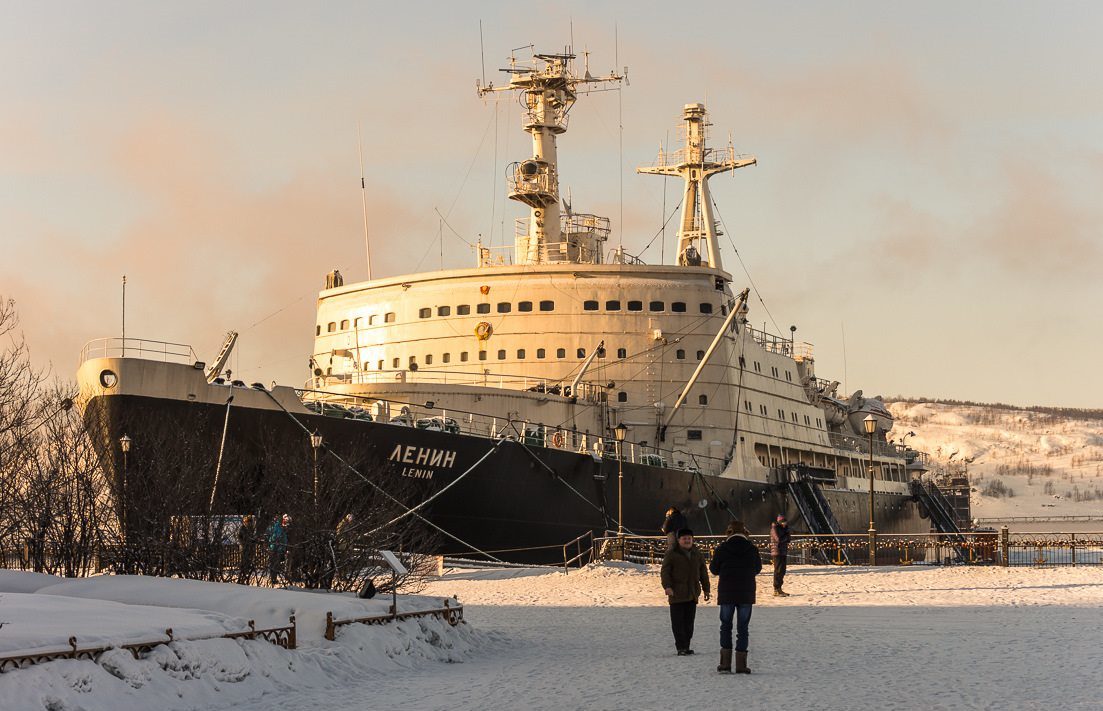
The Murmansk Shipping Company (whose representatives took part in the construction of Lenin at the Admiralty shipyards) managed to gather such an experienced crew to the point where even during the very first navigation (which lasted 3 months and 10 days) many forgot that the operation was still in “beta” mode. During this time, the nuclear-powered icebreaker covered 10 thousands nautical miles, 7 thousand of which were in severe ice conditions. 92 cargo ships were provided a route in the Barents and Kara seas. The navigation of 1961 opened a new era for explorers of the Arctic ocean. The nuclear icebreaker Lenin brought the North Pole-10 expedition to the East Siberian sea in time and with all its amenities. Then, it picked the “best” ice floe north of Wrangel Island and carefully unloaded 510 tons of equipment onto it: collapsible houses, warehouses for combustibles and food, as well as a whole set of research equipment. On its way back to Murmansk, Lenin, while following the northern latitudes, completed the second part of its task: it placed DARMs (drifting automatic radio-meteorological stations) along the edge of perennial ice. With the advent of the first nuclear-powered ship, knowledge of the Arctic ocean and climate expanded quickly and became much more complete, and this is another important contribution of the nuclear ice breaker fleet to the development of the country.
A new era in the development of the Northeast Passage
In 1966, after 6 years of operating the nuclear icebreaker, it was decided to replace its nuclear reactor unit by 3 OK-150 reactors and 2 OK-900. The latest being a brand new creation of designers supervised by Igor Afrikantov. There are many wonders, large and small, in the atomic project, but even then the OK-900 remains a unique creation. The project around this reactor was developed back in the 60s, but its designed turned out to be successful to the point where its modernized version, the OK-900A, is now the basis of the nuclear power units used in Russia’s most powerful icebreakers: “50 Years of Victory” and “Yamal”. The two OK-900 reactors abord the Lenin icebreaker provided it with a propeller force of 44 thousand horsepower, which is exactly the same with three OK-150 reactors. The new steam generating unit and the reactors themselves were much more accessible during maintenance work and repairs. This factor contributed to the decisions of replacing the reactor equipment, and of fitting and attaching the new unit into the ship’s hull. Out of the 675 rooms on the ship, 204 were completely re-defined and refurnished. Over the course of 6 years, many novelties were created for nuclear machinists and for the tool-making industry. With the modernization of Lenin, came the installation of 6200 new units of machinery and equipment, of which over 30 units were prototypes of core equipment. Boris Sokolov, the captain of Lenin from 1961 and until the last day of its operation, and the main advocate for the project of transforming the nuclear icebreaker into the Museum of Arctic Exploration. In 1970, a completely new ship left the Murmansk port, though this ship could hardly compete with the Lenin at its service debut.
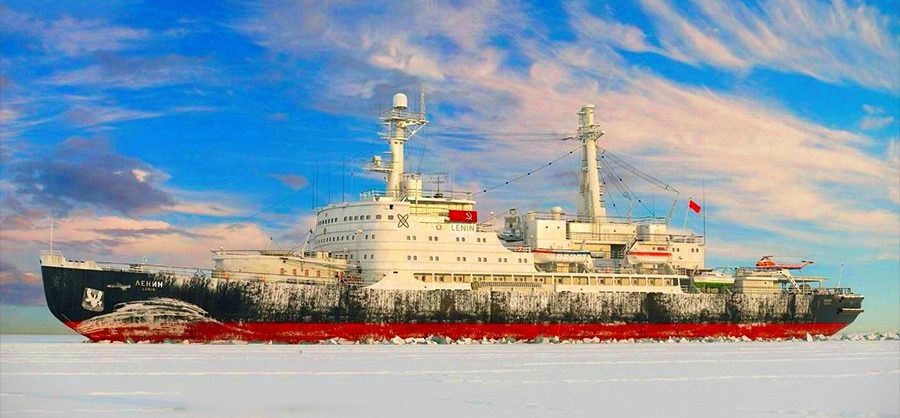
In 1970, the the Lenin nuclear-powered icebreaker confidently withstood its first extended navigation after being fully modernized: it escorted the “Gizhiga” diesel-electric ship from Murmansk to Dudinka from November 14th to December 1st. It had never been seen before for ships to travel across the NSR at such a late time of the year. In 1971, Lenin began its early journey by picking up the “Vladivostok” diesel-electric icebreaker in Murmansk and bringing it to the port of Pevek on June 22nd. With every passing year, sailors of the Murmansk fleet were more and more convinced that Lenin could cope even with the most difficult tasks that previously seemed impossible, which lead to a more thorough development of the NSR. Already by the end of March 1976, Lenin took the diesel-electric ship “Pavel Ponomarev” (the ship was named after the first captain of Lenin whose career began on board of the “Krasin” and “Ermak” icebreakers and went on a journey which was later called the “First Yamal experimental”: the cargo was delivered Cape Kharasavey, where it was awaited by Komigazprom specialists. Yamal winter-spring travels have become quite usual nowadays, but the Lenin icebreaker was indeed the first to pave the way.
“Arctic” icebreakers and icebreakers of Siberian rivers
The nuclear icebreaker Lenin amply demonstrated even to the most convinced skeptics that such equipment is capable of ensuring reliable development for the NSR and the coast of the Arctic Ocean. After carefully weighing all the pros and cons, having taken into account all the gained experience, the country’s leadership decided to start on the industrial production of a new generation of nuclear icebreakers, the “Arctic” category projects 10520 and 10521. Icebreakers of the Arctic category are the core of Russia’s nuclear icebreaker fleet as 6 out of the 9 ships of the fleet belong to this category. The OK-900A reactors are not the only new creations of Iceberg and the OKBM; there are also new turbines that provide a shaft power of 75 thousand horsepower, whereas Lenin had 44 thousand, although the force of the reactors themselves doesn’t differ that much (159 MW for OK-900 and 171 MW for OK-900A). Icebreakers of the “Arctic” category became 2.5 meters wider, which allowed them to escort a vessel with a heavier load. They were also faster than Lenin, had a more advanced reactor control system which allowed them to almost halve the crew. However, the main difference is, of course, ice resistance: whereas Lenin coped with ice up to 1.7 meters thick, Arctic icebreakers confidently travel through ice up to 2.3 meters thick.
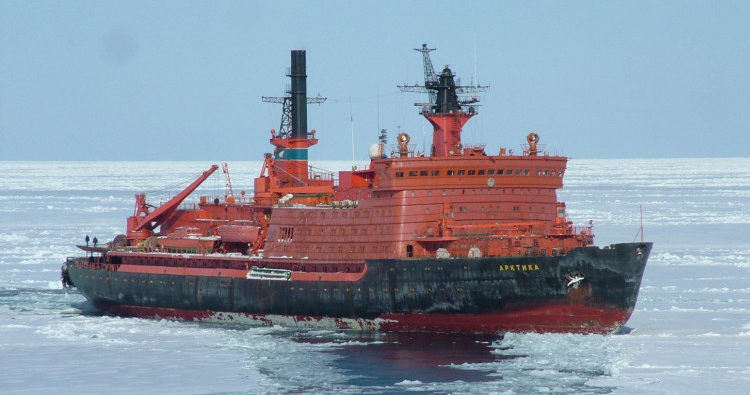
In 1975, the leading nuclear-powered icebreaker of this category was put into operation, bearing the same name: Arctic. During its journey of 1977, the Arctic accomplished what could surely be compared with the first expedition of man in space: having left Murmansk on August 9th after 7 days and 8 hours, the nuclear ship covered 2528 miles and on August 17th at 4 hours Moscow time, it had reached a word premiere in active navigation: the geographical point of the North Pole. The expedition leader, Minister of the Navy Timofey Borisovich Guzhenko and the captain of the nuclear-powered ship Yuri Sergeyevich Kuchiev pleased the government:
“During the travel, all of the icebreaker’s systems operated normally in the planned modes. All experiments planned by the expedition were fully completed. The obtained scientific and physical material will be used to further extend navigation along the NSR and to develop high-latitude transportation between the eastern and western regions of the North and the Far East in accordance with the decisions of the 25th CPSU Congress”.
The text is both businesslike and slightly naïve: those were the days, but this is indeed the journey during which the century-old dreams of sailors and polar explorers came true, and it will forever remain in history. Nowadays you can visit the North Pole as a tourist: the hundredth travel to the top of the Earth was completed in 2013, and in August 2017, the nuclear ice-breaker “50 Years of Victory” reached the North Pole in a record of three days, and back in 1977, the Arctic campaign became a real world sensation.
Icebreakers of the Arctic category were built with rhythm and confidence by nuclear engineers and the Baltic Shipyard, just like it’s supposed to be in production. After the Arctic nuclear-powered icebreaker, the nuclear icebreaker “Siberia” was put into operation in 1977, followed by “Russia” in 1985, “Soviet Union” in 1990, and “Yamal” in 1993. On December 29th, 1993, “50 Years of Victory” ,the largest nuclear icebreaker in the world (it was slightly longer than the rest of the Arctic category icebreakers) was launched, but due to a lack of funds its construction was suspended for a long 10 years. The flag on the ship was raised on March 23th , 2007. On April 11th, “50 Years of Victory” arrived at the port of its permanent registration, that is, in Murmansk.

To this day, two nuclear-powered ships of the Arctic category (Yamal and 50 Years of Victory) have ongoing work on the NSR. Rosatom, which was joined in 2008 by Atomflot, worked to extend the life of Yamal until 2028, and 50 Years of Victory will continue operating until 2035. Since 1990, Atomflot has been operating two small, “river” nuclear-powered ships, the Taimyr and the Vaigach, which were created specifically to enable cargo ships to be navigated to the mouths of the Ob and Yenisei rivers. These icebreakers belong to project 10580 and have a draught of 8 meters, which is 3 meters less than icebreakers of the Arctic category, and this allows them to work efficiently in the channels of Siberian rivers. Taimyr and Vaigach reactors, being equipped with nuclear power units based off the KLT-40M reactors, have a shaft power of 50 thousand horsepower, which is enough to cope with the ice situation there. KLT-40M belongs to the third generation of transport reactors. On the icebreakers of project 10580, the nuclear steam generating units operate with one reactor instead of two, whilst the shaft power of these icebreakers is greater than that of Lenin with its three OK-150 reactors.
Atomflot enters the 21st century
Are two Arctic icebreakers enough for Russia at present? We shall recall that the record volume of cargo transportation via the NSR under the Soviet period was achieved in 1986, when it amounted to 6.5 million tons, with the nuclear icebreakers Sibiria, Arctic and Russia operated under Atomflot. This score was surpassed in 2016, when 7.5 million tons of cargo of all categories were transported via the NSR. The subsequent growth is impressive: 10.7 million tons in 2017 and 19.7 tons in 2018 with 30 million tons being expected by the end of 2019! The composition of Atomflot’s vessels is also increasing due to diesel-electric icebreakers: in order for the cargo to move along the NSR in an assigned rhythm, Atomflot has been implementing the Portoflot project since 2014 under an agreement with Yamal LNG. Icebreaking tugboats and port icebreakers ensure calls with the port of Sabetta at a pace that no one could have imagined before, that is through a gas carrier every 39 hours. Whether or not Portoflot ships will be able to cope with postings after NOVATEK implements the Arctic LNG-2 project, we will find out soon enough, though we cannot exclude the possibility that the number of Portoflot’s non-nuclear icebreakers will increase.
But the main prospect for the development of Atomflot (and, accordingly, the development of the NSR and the entire Arctic are of Russia) lies in the icebreakers of the brand new LK-60YA (22220) and LK-120YA projects, which are already being called icebreakers of the Leader category. Universal nuclear icebreakers LK-60YA (whose projects has been developed by the irreplaceable duet of OKBM and the Iceberg Central Design Bureau) will be the next step in the taming of the Arctic Ocean. They are universal because they can be operated in the open sea just as well as in Siberian rivers, having the ability to change their draft depending on the depth of the bottom of the water. “LK-60” is also a spoken abbreviation: the shaft force of these icebreaker will be 60 MW, or 82 thousand horsepower. Based on their experience of creating and operating reactor installations of previous generations of nuclear icebreakers, OKBM specialists developed a project for the RITM-200 integrated reactor installation which consists of two reactors with a capacity of 175 MW each (the capacity of the previous generation of KLT-40 reactors is 140 MW, and the one of the KLT-40M reactors is 150 MW). Also, the RITM-200 is almost twice as light and more compact, which implies it being cheaper in terms of materials used as well as taking less space on the ship, that is, much more cost-effective. In terms of structure, such a result was achieved due to the fact that steam generators that were previously located outside the reactor are now directly integrated inside of it (integrated layout). In addition to the latest reactors, a new generation of more powerful an maneuverable propulsion motors will be added to the nuclear icebreakers of project 22220. These are precisely what makes it possible to a completely new level of ice permeability: the LK660YA nuclear-powered ships will be able to cope with ice up to 3 meters thick, which is guaranteed to ensure year-round navigation in the western part of the NSR and increase the duration of navigation in the eastern part.
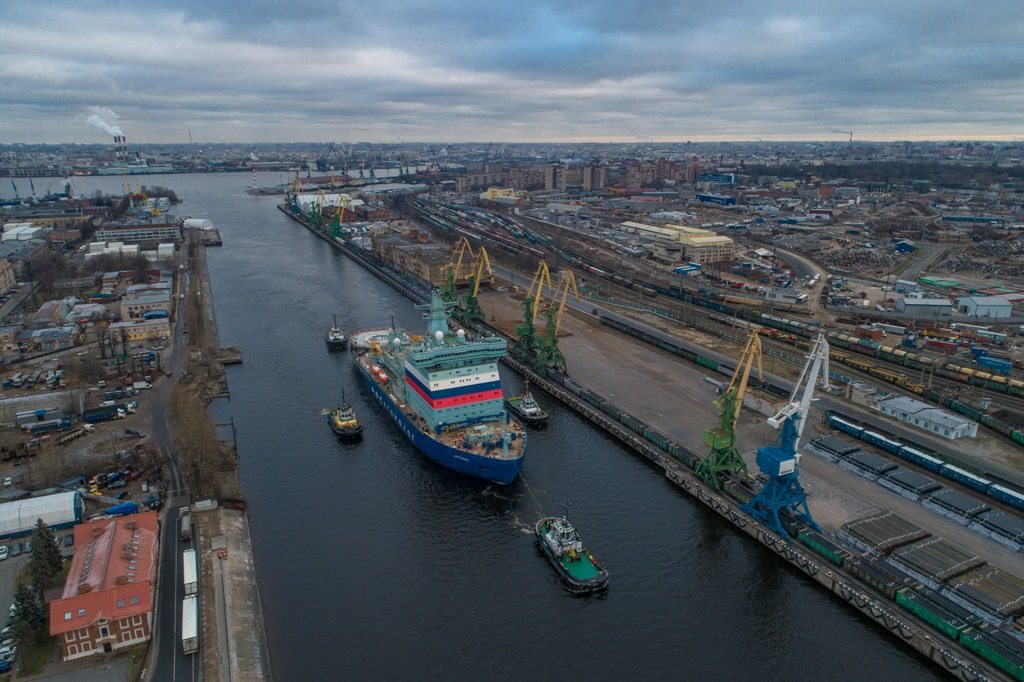
Atomflot expects that by the second quarter of 2020, shipbuilders will deliver a nuclear icebreaker of the new generation called Arctic. On December 12th, 2019, the Baltic Shipyard began its sea trials. Physical launches of both onboard reactors were carried out in October, and mooring trials of the Siberia (the second icebreaker of the 22220 project, and the first one to be produced) icebreaker began in November. Its delivery is scheduled for 2021. Simultaneously, the construction of the third icebreaker of this project, the Ural (whose production was launched in May 2019) is ongoing, and it is scheduled to replenish the Atomflot in 2022. In August 2019, Rosatom and the Baltic Shipyard signed an agreement on the construction of two additional icebreakers of project 22220 with the first one already to be launched in 2020. Its characteristics are the following: 173.3 meters long, 34 meters wide, displacement of 33.5 thousand tons, which will make the Leader icebreakers the largest in the world, and thus ensuring Russian leadership in the Arctic, but Rosatom’s plans extend even further.
The OKBM and the Iceberg Central Design Bureau are ready to take one more step further by creating nuclear icebreakers of the 10510 project, aka LK-120YA of the Leader category. It has a shaft power of 120 MW, which will allow icebreakers of this category to achieve results that seemed completely unrealistic until now, that ice, an ice permeability of over 4 meters. This indicator will provide an opportunity for year-round navigation even in winter ice conditions, from the Laptev Sea to the Bering Strait. The NSR will become “crossable” at any time of the year. Designers are ready to start working: Iceberg has developed a ship design, OKBM has developed the latest RITM-400 reactor with a thermal capacity of 315 MW, capable of continuous operation for 26 thousand hours. The main dimensions of this future icebreaker are the following: length of 209 meters, width of 47.7 meters, displacement of 71 380 tons. It will be capable of leading ships with a cargo capacity of over 100 thousand tons through the NSR. At the recent IX International Forum «Arctic: Today and the Future», Atomflot’s shipping director Leonid Irlitsa confirmed that Rosatom hopes to conclude a contract for the construction of icebreakers of the Leader category with the Far Eastern shipbuilding complex Zvezda in 2020. The parties are currently working on the terms of the contract and addressing financing issues. According to preliminary estimates, the construction of the Leader nuclear-powered icebreakers will take about 7 years, which is not that long of a period of time for such a breakthrough project.

If all plans for new nuclear-powered icebreakers come true, the most powerful icebreaker fleet will be able to fulfill two of the country’s most important tasks: the Arctic part of Russia will have good potential for development, as reliable year-round navigation along the entire Northern Sea Route will steadily allow the implementation of the project of its transformation into a new international transit route, which will allow a much faster delivery of goods from Europe to Asia and vice versa. Atomflot is not only full of energy to keep developing and turning century-old dreams into reality; its has already proven on more than one occasion that it is capable of doing so, and we are certain they will just as well succeed in their future plans.
Translated by Ellina Hensen
Original text: geoenergetics.ru


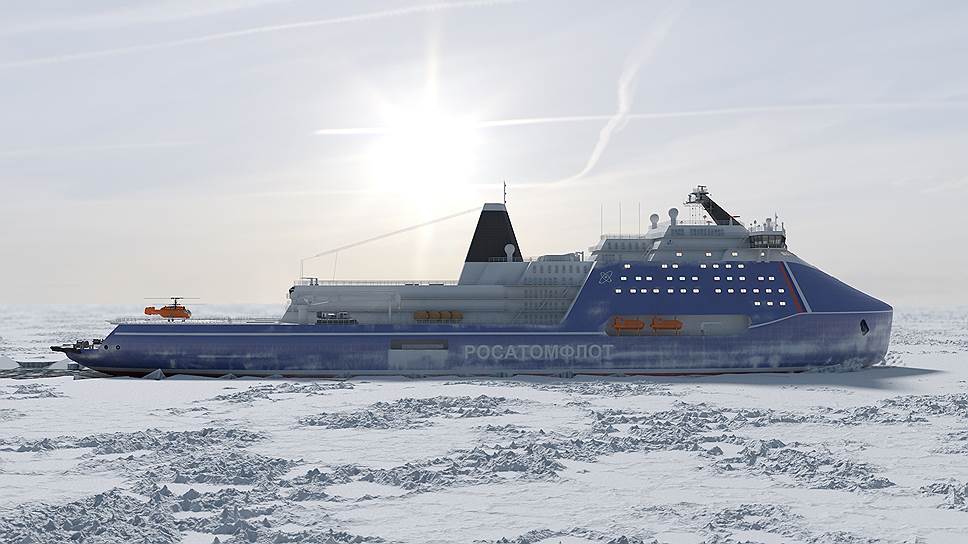
Спасибо!
Теперь редакторы в курсе.